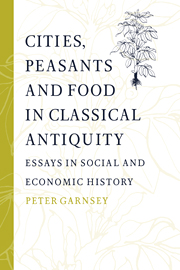Book contents
- Frontmatter
- Contents
- Preface
- Editor's preface
- Acknowledgements
- List of abbreviations
- PART I CITIES
- 1 Aspects of the decline of the urban aristocracy in the empire
- 2 Independent freedmen and the economy of Roman Italy under the Principate
- 3 Economy and society of Mediolanum under the Principate
- 4 Urban property investment in Roman society
- 5 An association of builders in late antique Sardis
- PART II PEASANTS
- PART III FOOD
- Bibliography
- Index
3 - Economy and society of Mediolanum under the Principate
Published online by Cambridge University Press: 02 December 2009
- Frontmatter
- Contents
- Preface
- Editor's preface
- Acknowledgements
- List of abbreviations
- PART I CITIES
- 1 Aspects of the decline of the urban aristocracy in the empire
- 2 Independent freedmen and the economy of Roman Italy under the Principate
- 3 Economy and society of Mediolanum under the Principate
- 4 Urban property investment in Roman society
- 5 An association of builders in late antique Sardis
- PART II PEASANTS
- PART III FOOD
- Bibliography
- Index
Summary
Strabo called Mediolanum (Milan) an and classed it above all other cities in the region of Cisalpine Gaul, with the exception of Patavium (Padua). Patavium in its prime, the Augustan period, could register five hundred equestrians in a census, a number equalled only by Gades (Cadiz) among cities in the West. The presence of so many equestrians indicates a substantial population-base. Cisalpine cities as a whole impressed Strabo as being larger and richer than those of the rest of Italy.
Thus, if Strabo is any guide, Mediolanum was already in his time (the beginning of the Principate), an important city, perhaps not far behind Patavium in size. Moreover, the fortunes of Mediolanum, unlike those of Patavium, were not on the wane. No contemporary of Augustus could have forecast that Mediolanum would be chosen as a seat of emperors in the fourth century. But seen in the light of the city's development in the early empire as an administrative, cultural and economic centre, this was a logical choice.
In this study of Mediolanum I discuss economic activity, aspects of social structure, and the relation between them. It does not need demonstrating in detail that the principal economic asset of Mediolanum, like that of most ancient cities, was its rural hinterland. But closer investigation of possible secondary economic activities of the city and in particular its trading links with other cities in the region and beyond is required.
- Type
- Chapter
- Information
- Cities, Peasants and Food in Classical AntiquityEssays in Social and Economic History, pp. 45 - 62Publisher: Cambridge University PressPrint publication year: 1998
- 1
- Cited by



